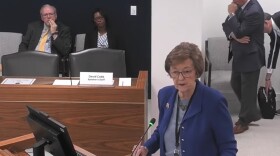A court ruling last week in a Currituck County case could have echoes across North Carolina, including in Buncombe County.
The case centers on the ways counties and municipalities can use occupancy tax dollars, which are paid by visitors every time they stay in commercial lodging such as a hotel or short-term rental.
In last week’s ruling, the North Carolina Court of Appeals unanimously sided with the plaintiffs, who had accused coastal Currituck County in 2019 of improperly spending the occupancy tax revenue on police, fire, EMS and other public safety services instead of on “tourism-related expenditures.”
The plaintiffs in the case were a group of local homeowners as well as the Corolla Civic Association.
Currituck County officials are now scrambling to figure out a way forward. At stake is more than $40 million the county spent over a span of 15 years.
Days after the ruling, Chris Cavanaugh, president of the Asheville-based Magellan Strategy Group, delivered a presentation on the issue to attendees at the Buncombe County Tourism Development Authority’s (TDA) annual planning session.
Cavanaugh, who was also previously chairman of the TDA and served on the state travel and tourism board, told the group Friday that in more than 40 years of occupancy tax legislation, the Currituck ruling may be the first that attempts to tackle the question of what constitutes a “tourism-related expenditure.”
“The staff and board members of a publicly-funded TDA have a fiduciary duty to ensure that lodging tax dollars are spent in accordance with the specific legislation and rules governing their use,” Cavanaugh emphasized in one of his presentation slides.
Ninety counties and 110 municipalities in North Carolina are currently enabled by federal law to collect occupancy tax, Cavanaugh said. Most occupancy taxes range from 1% to 6%. In Buncombe County, the tax rate is 6%.
Buncombe County collected $37.5 million in occupancy tax revenue during the 2021-2022 fiscal year, the third-highest total in the state, according to a Magellan analysis. Only Mecklenburg and Dare counties collected more. Currituck ranked fifth, with $17.9 million that year.
Most counties and municipalities are mandated by law to split their occupancy tax revenue into two buckets. One bucket is for “destination promotion,” which includes marketing and advertising to attract more visitors to the area. The other bucket is for “tourism-related expenditures,” which can include investment in community capital projects.
For years, Buncombe County had been required to spend three-quarters of its occupancy tax revenue on “destination promotion” and one-quarter on “tourism-related expenditures.” A state law in 2022 changed that ratio, with two-thirds now going to destination promotion and one-third toward tourism-related expenditures.

Vic Isley, president and CEO of the Buncombe County TDA, said at Friday’s annual planning session that the TDA expects to spend a maximum of $18.9 million on tourism-related expenditures in 2024, split equally between two funds. One is the Legacy Investment From Tourism (LIFT) Fund. The other is the Tourism Product Development Fund (TPDF).
Both funds accept applications only from nonprofits and government entities. A committee is expected to present its recommendations for the latest round of LIFT projects next month.
Among the LIFT applicants is the Buncombe County government, which submitted a $6 million proposal for the Ferry Road affordable housing development.
The Asheville City Council has applied for LIFT funding for city sidewalks, multimodal transportation, greenways and repairs to the Thomas Wolfe Auditorium and Harrah's Cherokee Center.
In Currituck, the county transferred occupancy tax revenue to its general fund and then spent the money on public safety services.
Buncombe County, by contrast, has largely focused on capital projects – often to the chagrin of local residents, some of whom argue that the county should spend less on attracting visitors and more on community infrastructure and affordable housing.
The TDA has noted that TPDF funds have previously gone toward projects such as the North Carolina Arboretum, Pack Square Park, the Enka Sports Complex and local greenways.
The fund is also providing a multi-year, $23 million investment in renovations for McCormick Field. Five more large-scale projects may also be funded in the coming years, at a cost of $19- to $28.5 million each, Isley said. Those projects have yet to be decided.
Laura Hackett contributed to this report.







